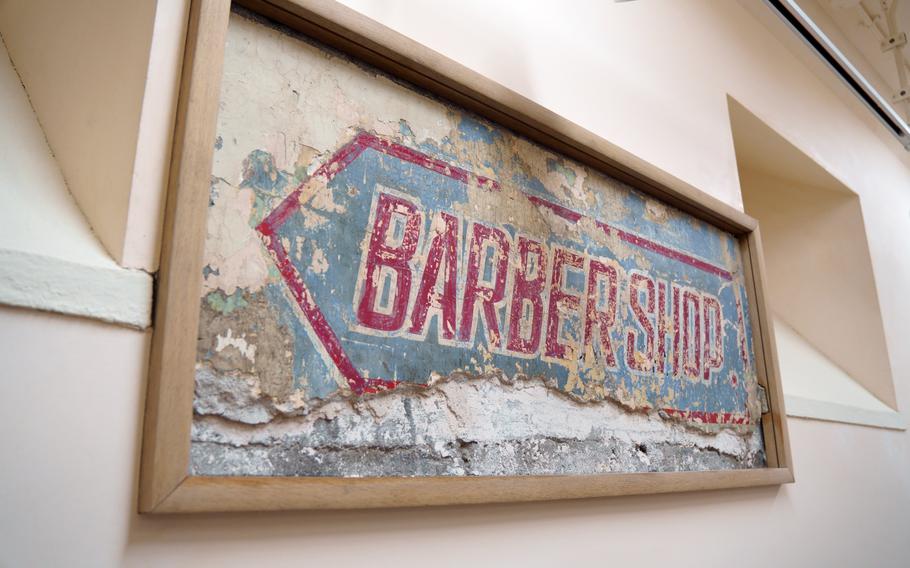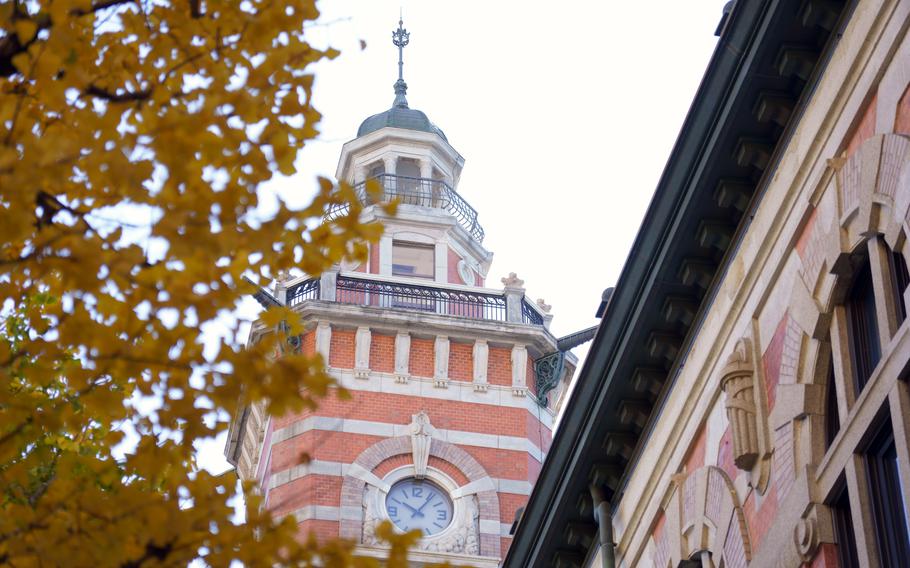
A sign pointing the way to an occupation-era barbershop was recently uncovered during renovations to Yokohama City Port Opening Memorial Hall in Yokohama, Japan. (Akifumi Ishikawa/Stars and Stripes)
YOKOHAMA, Japan — Restoration of a city landmark here last year uncovered images of the post-World War II occupation by U.S. forces, reminders now preserved for the stories they tell.
The word “barbershop,” for example, along with an illustration of a man in a suit, turned up during a survey of a plastered wall at Yokohama City Port Opening Memorial Hall.
“The walls were damaged, so workers were carefully removing the plaster when traces of the paint appeared,” Shota Kutsukake, an official in the Yokohama city building maintenance division, recently told Stars and Stripes.
Workers found what seems to be a sign pointing the way to a barbershop, which is written in red on a blue background and framed in white. It was discovered in the memorial hall’s basement, just below the main entrance, Kutsukake said.
When workers broadened the area where they removed the paint, the sign appeared, he said.
The illustration of a man’s upper body wearing a green suit was uncovered on another wall in the same room as the barbershop sign, Kutsukake said.
In an adjacent room, workers discovered the words “fire alarm” written in red but painted over in blue.
City officials believe the discoveries date to between 1945 and 1958, when American occupation forces used the building in the city south of Tokyo.
Yokohama residents donated money to build the hall in 1917 to commemorate the 50th anniversary of Yokohama port’s opening, according to the city’s official website.
The building stood out by its Western design using red bricks and lines of white granite. Its clock tower is known as Jack’s Tower.
It was mostly destroyed by the Great Kanto Earthquake of 1923, except for the clock tower and part of the wall. It was repaired in 1927.
The U.S. military seized the building after the end of World War II, although few records are left about what went on there.

Occupation-era signs and wall illustrations were recently uncovered during renovations to Yokohama City Port Opening Memorial Hall in Yokohama, Japan. (Akifumi Ishikawa/Stars and Stripes)
The Americans returned the building to Japanese control in 1958. It has served the city’s Naka ward as a public hall, where rooms are rented out for concerts, lectures and meetings. The building was designated as a national important cultural property in 1989.
A blueprint of the building under U.S. military use showed part of it was used as a movie theater, according to Kutsukake.
The city hopes the discovery will lead to more information about its use by occupation forces.
“Wow. Just wow,” were the only words that came to mind, said Hisayuki Kinoshita, a Japan Cultural Heritage Consultancy researcher, who led the survey of the walls during the renovation.
The building has been renovated several times since 1958, but this is the first time any reminder of the U.S. occupation has surfaced, Kinoshita said.
The city will preserve the writings and the illustration. They have been framed and covered with clear plastic to preserve them.
The hall is scheduled to reopen in April.
The basement is off-limits to the public and the city has no immediate plans to display the discoveries, Kutsukake said.